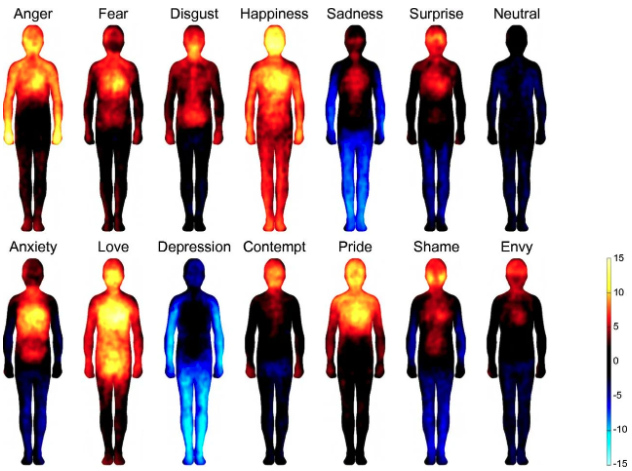Most of us can recollect how our bodies feel when we’ve experienced certain emotions. Many of us feel our cheeks flush when we’re embarrassed, or a tightness in our chests when we feel anxious.There can be unique differences in sensations from person to person, but studies have shown where emotions are generally experienced.
For example, A Finnish study from 2013 mapped bodily reactions in around 700 people. They found patterns in how each feeling was felt within their bodies. Emotions associated with fear, anger and anxiety showed increased sensations in the chest, face and upper body. These emotions were also found to get the body ready for quick action by increasing heart rate and tightening muscles.
Below is a chart from the study which shows where participants felt each emotion in their body.
It’s clear that different emotions impact our physical body, so what happens if we consistently feel lots of challenging emotions over a short period of time? What happens to the body when we are chronically stressed?
Stress affects all systems of the body including the cardiovascular, musculoskeletal, respiratory, endocrine, nervous, gastrointestinal, and reproductive systems. These systems can handle stress in small doses but when stress becomes chronic, it can have a serious impact on us.
When we bottle up our emotions or refuse to acknowledge them, they can stick around in our subconscious, which in turn, can impact the way we move and hold ourselves. When we feel down or unconfident, we are more likely to hold our head down as we walk and our posture can slack. We may experience more back pain and migraines as our muscles become consistently tight with the tension stress causes.
Essentially, our entire bodies have to work extra hard to function when we are chronically stressed, which can cause us to not only feel tired, but for our immune systems to get tired too, leaving us more vulnerable to infections and illnesses.
How do we release emotions from the body?
Sometimes we may feel like we need to cry, scream, punch a pillow or generally move to ‘release’ our emotions. Crying often feels cathartic as it allows us to let things go. When crying, we freely express ourselves, bringing relief from the tension we have been storing.
- Recognize – The first step is to connect with and understand your emotions. When we get into the habit of repressing emotions, it can be hard to even identify them. Particularly, if they are emotions we have come to feel ashamed of. Think about what you believe this emotion is stemming from and identify how this event or situation makes you feel.
- Respond – Emotions need to be expressed to be processed. Emotions create energy within us, as we can see on the above heatmap chart. Allow yourself to feel the emotion and pay attention to how your body feels in that moment. Try to move the energy out of the body to let it go. You may feel the need to cry, scream into a pillow, walk, run or dance it out, hit a punching bag, do some yoga, or simply breathe deeply —whatever feels right in that moment, do it.
- Reset – Take time to slow down and connect with yourself. Do whatever makes you the happiest (but also won’t make you feel bad or guilty afterwards). You could listen to music while you cook your favorite dinner, take a bubble bath or a nap to restore. The goal is to reset and try to replace the stressful emotions with a spark of joy or peace.

